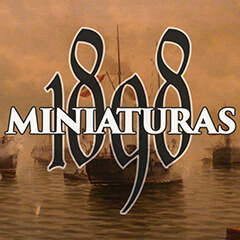RAYADILLO: THE SPANISH OVERSEAS UNIFORM
1898 Miniaturas
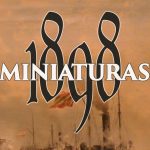
Illustrated guide to the famous rayadillo, the Spanish overseas used in Cuba and the Philippines between 1868 and 1898. Artwork José G. Morán. Click on the illustration to read the descriptions
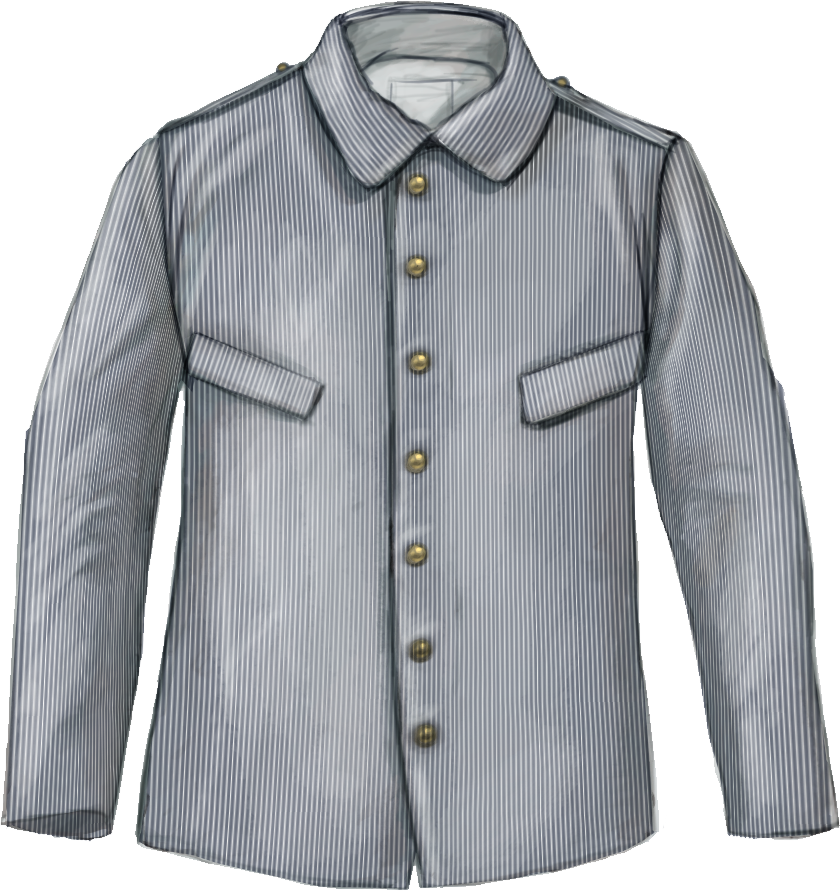
Infantryman or Cazador coat
This coat with rolled collar and shoulder straps made of rayadillo striped fabric, usually made of cotton although also made of linen or hemp, was the most commonly used. It was present both in Cuba and Puerto Rico as in the Philippines, although with some differences in fabric and shape due to the great variety of manufacturers both in mainland Spain and overseas. It began to be used in Cuba between 1852 and 1854 as a result of the research for a practical and economic uniform. The stripes, 1.6 mm wide and separated with a 0.6 mm gap, were of Prussian Blue color, although they quickly faded because of the climatology of the tropics and the constant laundering that uniforms had to endure.

Guayabera
A rayadillo garment that was widely used by Spanish troops in Cuba and Puerto Rico to replace the jacket. It had a rolled collar, creases on the chest, two pockets on the front tails and a row of bone buttons covered by a lapel.

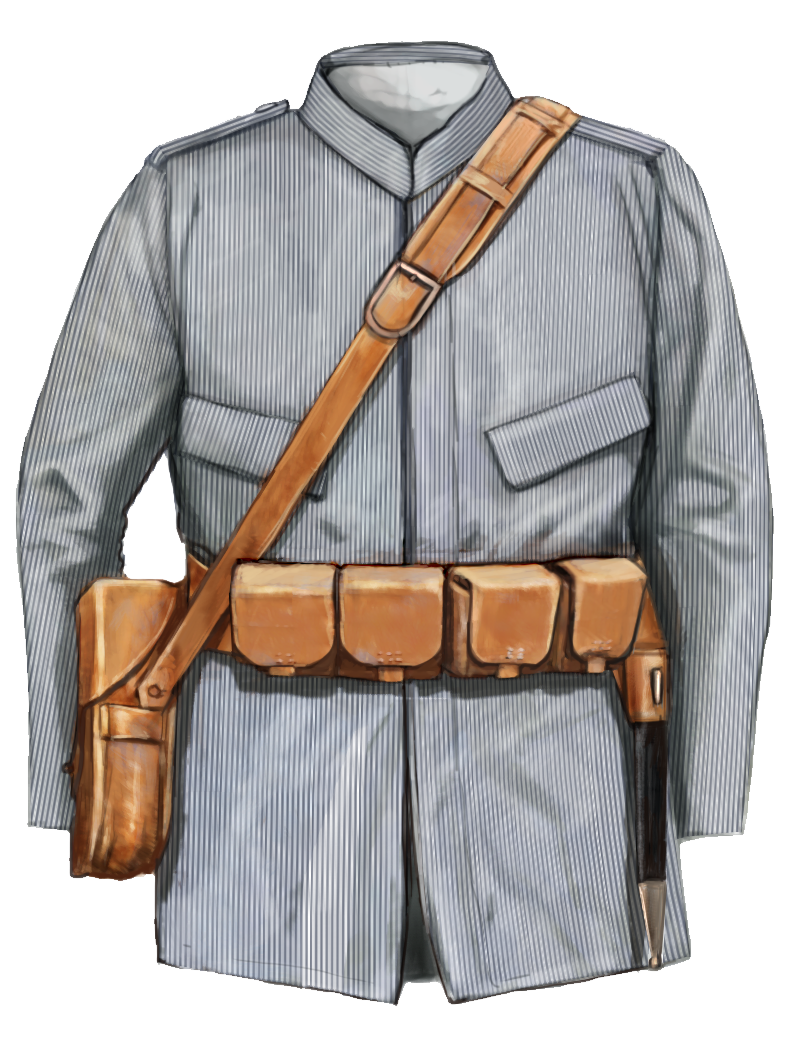
Standing collar coat
Used in the Philippines. The bone buttons were covered by a lapel. The figure shows the Colonial Infantry Equipment 1896 Pattern that was issued to the last troops sent to both Cuba and the Philippines. It consists of a girdle with a buckle from which hangs a four-pocket cartridge, a bayonet sheath and a larger holster attached to a strap crossing over the left shoulder, all made of uncolored, or hazel colored, leather.

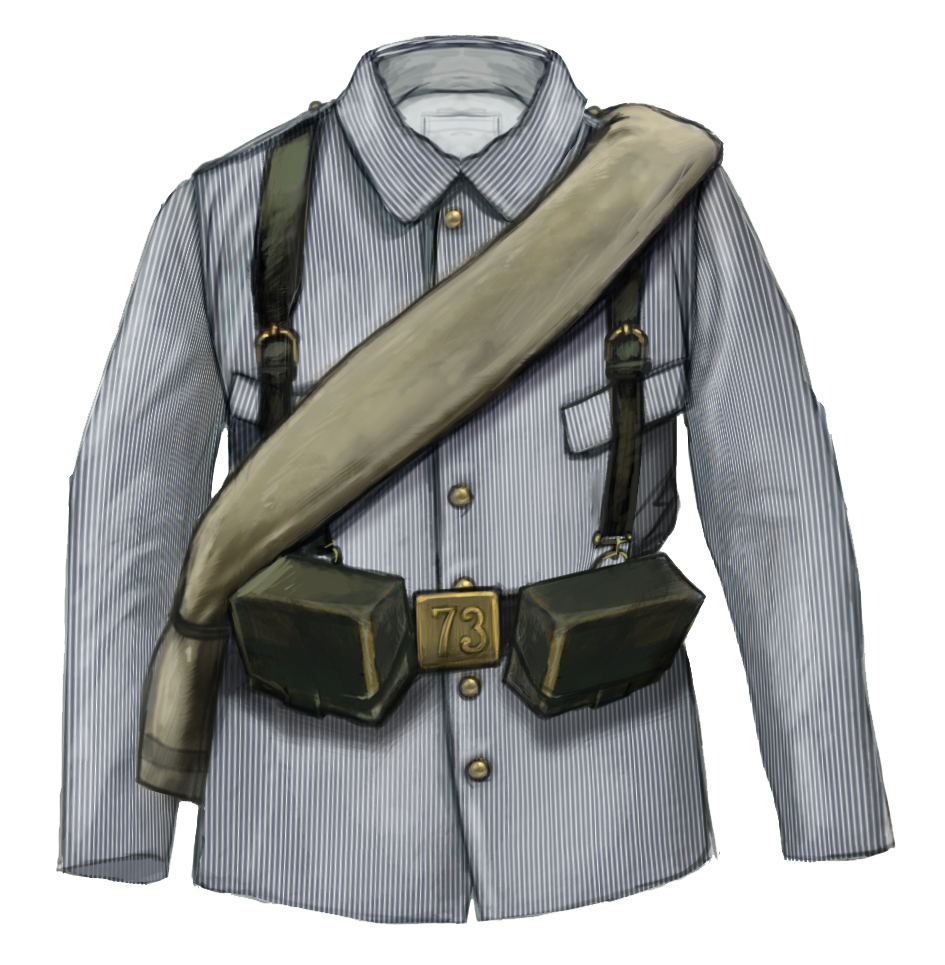
Blanket
Usually carried in campaign rolled over the chest. Colour stripes can be appreciated close to the edges in contemporary photographies.
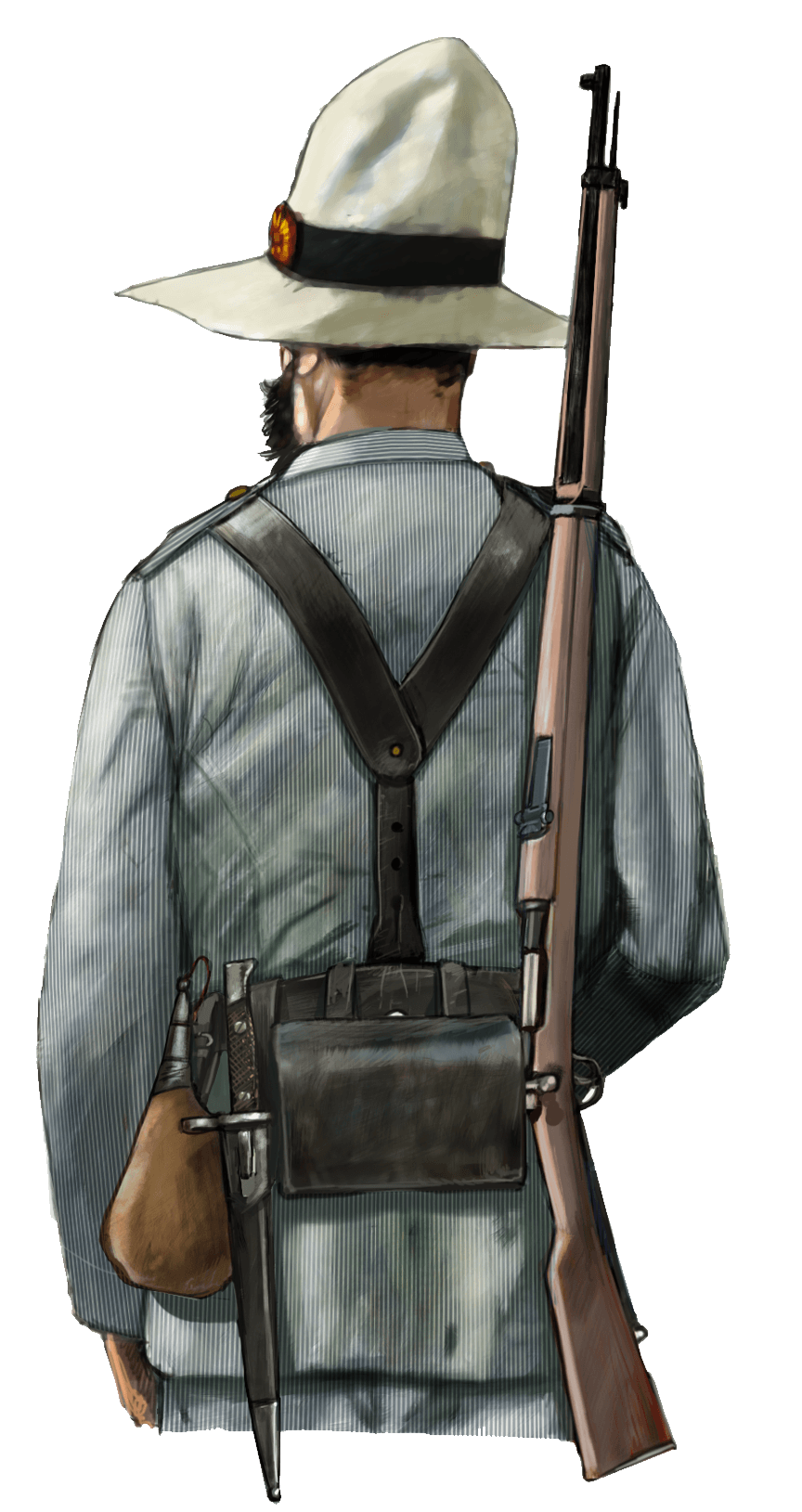
1898 Spanish soldier, rear view
It shows us the wineskin issued to the troops who went to Cuba from 1897 onwards. It was scarcely distributed to the troops sent to the Philippines, as it happened to the last battalions of hunters sent in the aftermath of the conflict. We can also appreciate the Mauser’s bayonet sheath and the back cartridge box, wider than the front ones. He wears a guano hat or yarey, much cheaper than the jipijapas, which were issued to the troops when they arrived in Cuba and used on campaign. A black ribbon and a cockade with the national colors were given with the hat.

1898 Spanish soldier, front view
He wears a rayadillo rolled collar jacket with a rayadillo trouser, fastening a leather with cartridge boxes to hold ammunition for the Model 1893 Mauser rifle. The clasp of the girdle showed the number of the regiment, inside a bugle in the case of the cazadores battalions. In some cases it was placed on the collar (especially on garrison troops, not so usually on field troops). In Cuba, soldiers were equipped with a long machete hanging from the girdle on the left side, just like the bayonet. He wears boots (although the use of guajiras and espadrilles was common) and a jipijapa or panama, a straw hat that was usually worn for daily use or strolling.
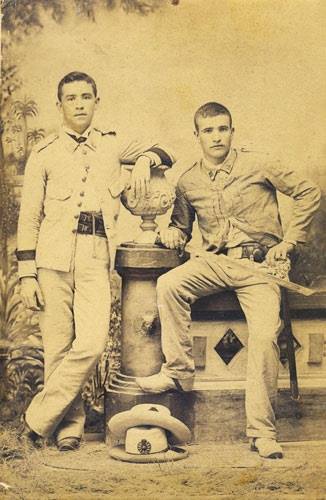
RANK INSIGNIA

Shoulder rank insignia
In 1898, for Royal Order, the officers’ braids were moved from the cuffs to the shoulders, in order to ease their identification. They were displayed on a cloth rectangle sewn perpendicularly to the shoulder, that is, from the back to the chest. The colour of the cloth depended on the branch the officer served:
- Green for Infantry
- Dark blue for Cavalry
- Red for Artillery
- Yellow for Medical Services
The braids were sewn horizontally on the cloth rectangle and consisted of:
- Three stripes for the captain
- Two stripes for the lieutenant
- One stripe for the sublieutenant
The generals used to wear a sash with the braids sewn forming a vertical stripe in the front part of their full dress uniform.
Braid colour
The color of the braids depended on the branch:
- Golden for the Infantry, the Artillery, the Carabiniers, Hussars, the Staff and the Medical Services.
- Silver for the Cavalry (except Hussars), the Civil Guard, the Engineers, the Carabiniers from the Philippines and the Militar Administration.

Cuffs rank insignia
From 1884 to 1908 (1898 in overseas), the officers wore their insignia of rank in the cuffs of the jacket. It consisted on a mixture of cords and stars made of gold and silver thread, depending on the colour of the officer´s buttons, with the exception of the major and the sublieutenant, who combined the gold and silver thread with the red cords which the sergeants and the first class soldiers wore in the sleeve.
Before 1896, the insignia was sewn in a removable cloth cuff with the color of the branch. After 1896, in Cuba the coloured cuffs were removed and the insignia was directly sewn to the cuffs , though during the campaign the cords were not worn and the stars were only used in order to make the officers less visible to the mambises’ shooters. In Puerto Rico the officers continued wearing the coloured cuffs till the end of the war, while in the Philippines the braids were removed from the cuffs and started to be worn on the shoulder pads in 1887.
A six-pointed star:
- One – Sublieutenant
- Two – Lieutenant
- Three – Captain
An eight-pointed star:
- One – Major
- Two – Lieutenant Colonel
- Three – Colonel
A four-pointed stars with a sword over a sword:
- One – Brigade general
- Two – Division general
- Three – General lieutenant
A four-pointed star with a cane over a sword:
- Three – Captain general
From left to right: First Corporal (red chevron), Sergeant (gold chevron), Lieutenant (two six pointed stars) and Captain (tree six pointed stars).

Officer’s cap
In addition to the shoulder, the officers wore braids in their peaked cap and their fatigue cap. These were displayed in horizontal stripes around the cap, slightly over the visor. Regarding the hats (jipijapas), the braids were displayed horizontally in the cockades.
WEAPONRY

Spanish Mauser 1893 Pattern

Remington rifle

Machete
EQUIPMENT

Remington rifle equipment
Rifle in use until the Mauser was issued to the troops. The Royal Ordinance of July 8, 1891 ordered that this model was to be reformed to adapt it to the Mauser’s ammunition, replacing the right cartridge box with a rectangular cartridge box like the left one, and enlarging the rear cartridge box. The baldric was also enlarged to adapt it to the new bayonet.
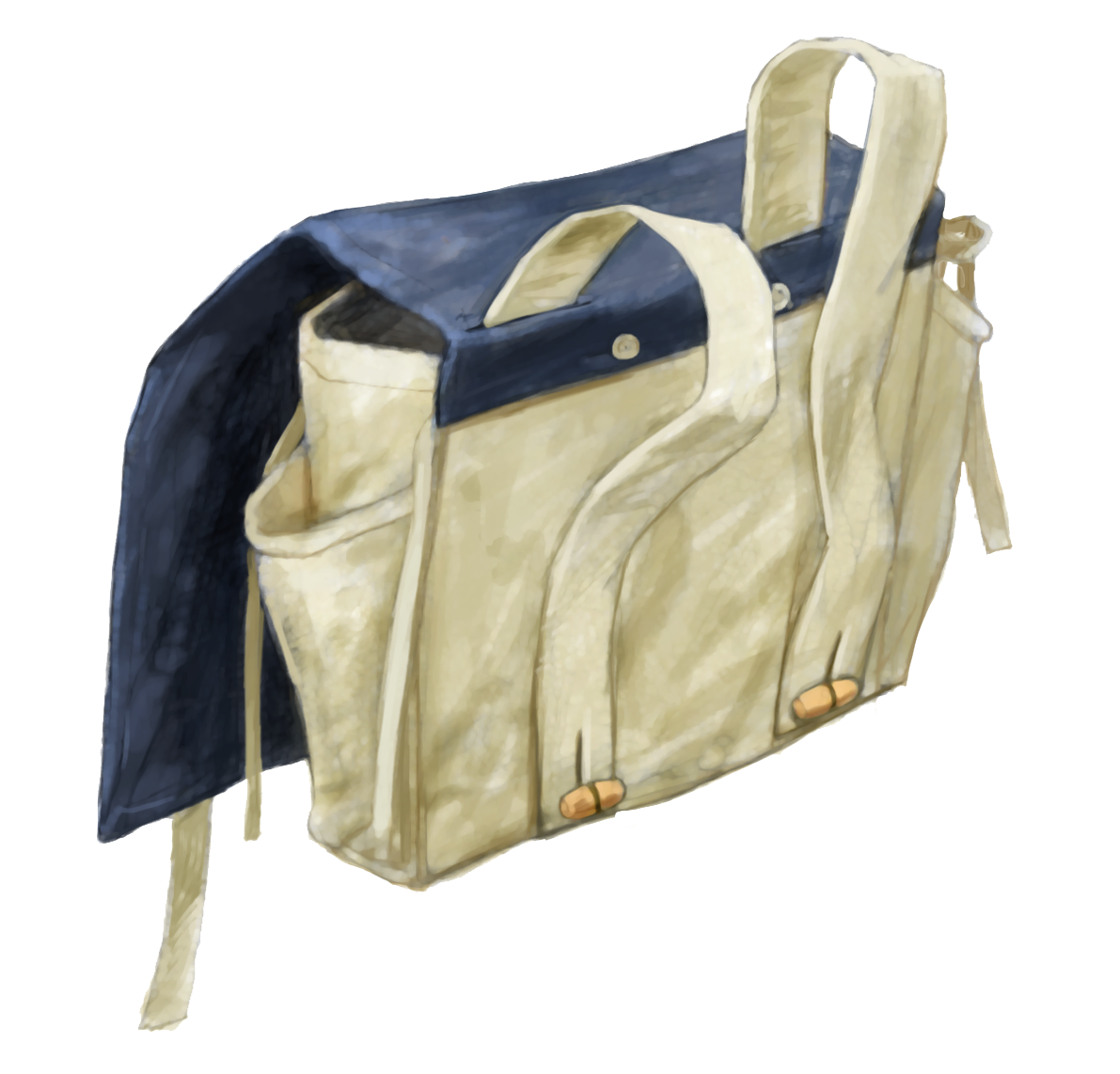
Backpack
Infantry backpack.

Canteen
Metal canteen, it was usually hooked on the front of the girdle, or in the backpack.

Undress cap
Used by line infantry, a rayadillo version appeared in the final stages of the war.


Guajiras
Leather sole slippers commonly used in Cuba and widely used by Spanish soldiers, that were given as part of the uniform along with a pair of high, laced boots, as happened with the sixteen battalions of the Great Expedition of 1896. A pair of guajiras were issued to the cazadores units sent to the Philippines at the end of the conflict. Many soldiers also received a pair of espadrilles.
Bombón de caña
Canteen made with a piece of bamboo cane. In Cuba it was used the jícara instead, made with the fruit of the güira (similar to the courgette). It was essential to transport drinkable water as streams and springs were usually polluted, especially in Cuba, a major source of illness with a dire death toll.

© illustration José G. Morán
Bibliography
Albi, J. (2013): Arcabuces, mosquetes y fusiles. Madrid: Ollero y Ramos.
Guerrero Acosta, J. M. (2003): El Ejército español en Ultramar y África (1850-1925). Los soldados olvidados del otro lado del mar. Madrid: Acción Press.
¡Rayadillo! The Spanish Colonial Uniform Research Project. William Combs website, a major source of information (in English).


